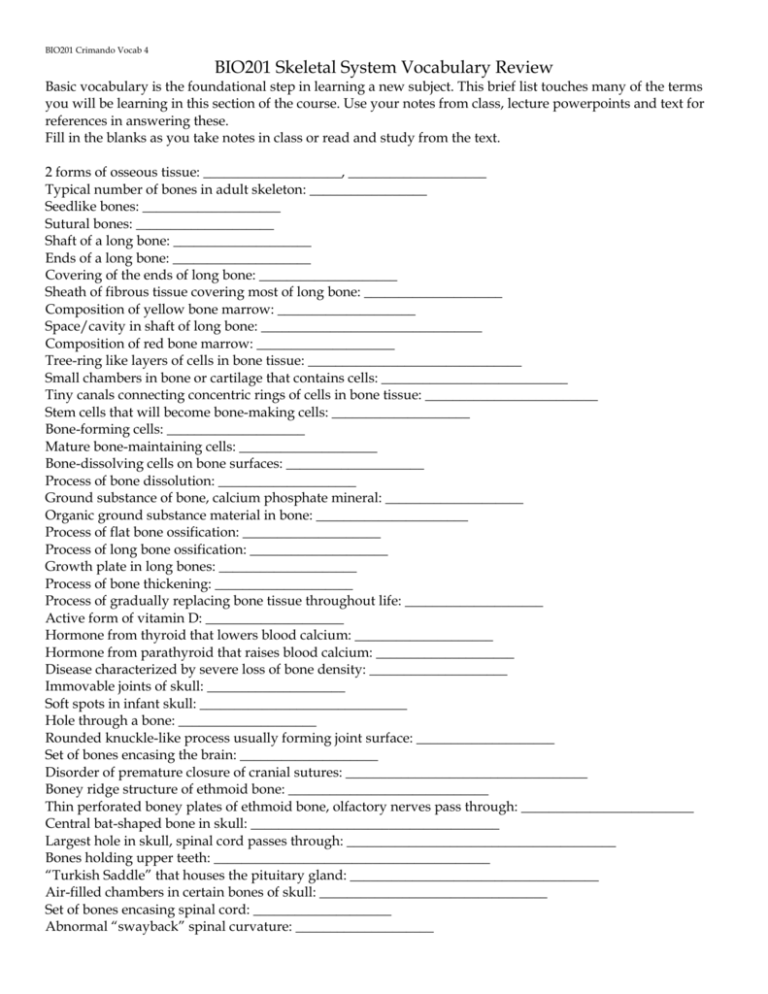BIO201 Crimando Vocab 4 BIO201 Skeletal System Vocabulary
advertisement

BIO201 Crimando Vocab 4 BIO201 Skeletal System Vocabulary Review Basic vocabulary is the foundational step in learning a new subject. This brief list touches many of the terms you will be learning in this section of the course. Use your notes from class, lecture powerpoints and text for references in answering these. Fill in the blanks as you take notes in class or read and study from the text. 2 forms of osseous tissue: ____________________, ____________________ Typical number of bones in adult skeleton: _________________ Seedlike bones: ____________________ Sutural bones: ____________________ Shaft of a long bone: ____________________ Ends of a long bone: ____________________ Covering of the ends of long bone: ____________________ Sheath of fibrous tissue covering most of long bone: ____________________ Composition of yellow bone marrow: ____________________ Space/cavity in shaft of long bone: ________________________________ Composition of red bone marrow: ____________________ Tree-ring like layers of cells in bone tissue: _______________________________ Small chambers in bone or cartilage that contains cells: ___________________________ Tiny canals connecting concentric rings of cells in bone tissue: _________________________ Stem cells that will become bone-making cells: ____________________ Bone-forming cells: ____________________ Mature bone-maintaining cells: ____________________ Bone-dissolving cells on bone surfaces: ____________________ Process of bone dissolution: ____________________ Ground substance of bone, calcium phosphate mineral: ____________________ Organic ground substance material in bone: ______________________ Process of flat bone ossification: ____________________ Process of long bone ossification: ____________________ Growth plate in long bones: ____________________ Process of bone thickening: ____________________ Process of gradually replacing bone tissue throughout life: ____________________ Active form of vitamin D: ____________________ Hormone from thyroid that lowers blood calcium: ____________________ Hormone from parathyroid that raises blood calcium: ____________________ Disease characterized by severe loss of bone density: ____________________ Immovable joints of skull: ____________________ Soft spots in infant skull: ______________________________ Hole through a bone: ____________________ Rounded knuckle-like process usually forming joint surface: ____________________ Set of bones encasing the brain: ____________________ Disorder of premature closure of cranial sutures: ___________________________________ Boney ridge structure of ethmoid bone: _____________________________ Thin perforated boney plates of ethmoid bone, olfactory nerves pass through: _________________________ Central bat-shaped bone in skull: ____________________________________ Largest hole in skull, spinal cord passes through: _______________________________________ Bones holding upper teeth: ________________________________________ “Turkish Saddle” that houses the pituitary gland: ____________________________________ Air-filled chambers in certain bones of skull: _________________________________ Set of bones encasing spinal cord: ____________________ Abnormal “swayback” spinal curvature: ____________________ Abnormal “hunchback” spinal curvature: ____________________ Abnormal lateral spinal curvature: ____________________ Birth defect with incomplete closure of vertebral column ______________________________ Number of cervical, thoracic and lumbar vertebrae: _______________, _______________, _______________ Fibrous joint (immovable) also called: ____________________ Cartilaginous joint (partly movable) also called: ____________________ Most freely movable type of joints: ____________________ Connective tissue enclosing synovial joints: ____________________ Fluid-filled cushion surrounding some joints: ____________________ Fibrocartilage pad between bones of knee: ____________________ Most common type of lever in musculoskeletal joints: ____________________ Term for joint dislocation: ____________________ Most easily dislocated joint in the body: ____________________ Set of four muscles that stabilize the shoulder joint: ____________________ Most important muscle in stabilizing the shoulder joint: ____________________ Lateral ligament of the knee: ____________________ Medial ligament of the knee: ____________________ Inner crossing ligament that stabilizes knee when flexed: ____________________ Inner crossing ligament that stabilizes knee when extended: ____________________ Common wear-and-tear joint disorder: ____________________ Inflammatory autoimmune joint disorder: ____________________ Joint disorder with uric acid precipitates in lower joints: ____________________







